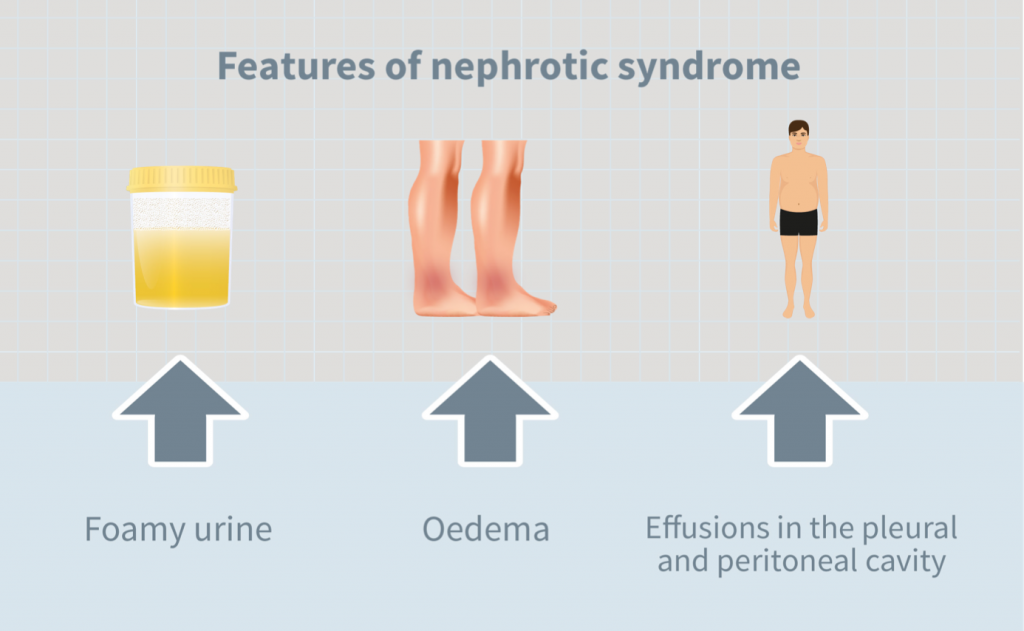Prof Ferruh Artunc – Uncovering the Mechanisms Behind Nephrotic Syndrome to Develop Novel Therapeutics
Kidney disease impacts many people throughout the world and it can sometimes take the severe form of nephrotic syndrome. This condition results in many difficult symptoms but it is best represented by the presence of oedema, which is the severe swelling of the legs and eyelids. Currently, the exact mechanisms underlying oedema formation are poorly understood. Prof Ferruh Artunc from the Tübingen University Hospital in Germany is using his expertise in nephrology to uncover these mechanisms. His work has strengthened our comprehension of oedema formation in nephrotic syndrome and it may even lead to novel therapeutics in the future.
Kidney disease: The Causes and Consequences
Kidney disease is a common disorder that tends to show up in older age. When it is first developing, kidney disease does not usually have any symptoms and so it is often diagnosed from the results of a blood or urine test that has been taken for another reason. There are many reasons a person can develop kidney disease. For example, high blood pressure or diabetes, an inherited condition called polycystic kidney disease, kidney stones and even long-term use of some medicines. These all put increased strain on the kidneys and cause disruption to their normal functioning.
The kidneys are supposed to act as a filtration system for the body, removing waste, extra fluid and acid produced by normal cell function into the bladder. They also maintain a healthy balance of water, salts and minerals like sodium in the blood to keep the muscles, nerves and other tissues working properly. When this system goes wrong and the kidneys fail to excrete sodium, people may experience shortness of breath, weight gain and oedema.
These symptoms should lead to testing for kidney conditions via a blood or urine test and perhaps a scan or biopsy to assess the extent of the kidney damage. Blood and urine tests search for unusually elevated levels of certain substances, such as the waste product creatinine in the blood or proteins in the urine. By estimation of the glomerular filtration rate, the doctor can determine how efficiently the kidneys are filtering the blood.
Although there is no cure for kidney disease, making healthy lifestyle changes can be greatly beneficial, in addition to medicines to control high blood pressure. To ease the swelling symptoms caused by excess fluid, some people are prescribed diuretics. More advanced disease can also be treated with dialysis to clean the blood and sometimes a kidney transplant is necessary. Most people with kidney disease are able to control and live with it for a long time and only a small proportion of people reach an advanced stage of the disease. Nevertheless, it is important to diagnose it earlier rather than later and have regular check-ups because untreated kidney damage can have serious consequences. Kidney failure, hypertension and congestive heart failure with lung oedema can all develop from untreated disease.

Credit Ferruh Artunc
Nephrotic Syndrome
One extreme type of kidney disease is known as nephrotic syndrome. Some symptoms are shared with other types of kidney disease, whilst some present as the opposite. For example, many people will experience weight gain as a result of intense fluid retention and swelling. Numerous risk factors are also the same between the two conditions, although nephrotic syndrome is seen more often in children compared to other types of kidney disease. This is as a result of the mysterious condition known as minimal change disease, whereby the kidneys are dysfunctional but tissue samples under a microscope appear completely normal and the cause of the dysfunction cannot be determined.
Although the causes and risk factors leading to nephrotic syndrome vary from person to person, one element is nearly universal. In nephrotic syndrome, there is damage to the glomeruli in the kidneys, which are clusters of tiny blood vessels and filter the blood. Various diseases of the kidney can lead to scarring of the glomeruli and the rest of the kidney tissue.
Glomeruli are an essential component of the kidneys and they help to filter waste and to remove excess water from the bloodstream while withholding blood proteins such as albumin. Albumin normally helps to maintain the right amount of fluid within the body but when the filtration barrier of the glomeruli is damaged, it escapes into the urine. For this reason, a hallmark of nephrotic syndrome is oedema alongside an especially high concentration of albumin in urine tests.
Once there is less plasma albumin available for maintenance of the circulating volume, water and sodium continue to accumulate in different parts of the body such as in the ankles, legs and eyelids after overnight rest. Unfortunately, nephrotic syndrome can result in other complications like blood clots, malnutrition and infections. But as with other kidney diseases, it can be partly remedied through treating some symptoms and ultimately by treating the underlying conditions.
Clearly, nephrotic syndrome is a well-documented pattern of kidney disease, but not all bases are covered when it comes to understanding it on a deeper level. Prof Ferruh Artunc is a medical doctor and researcher at University Hospital Tübingen in Germany and he is using his expertise to unravel the hidden mechanisms behind why oedema forms as a result of nephrotic syndrome. He hopes this may lead to novel and more effective approaches to treating oedema in the near future.
‘Our group is unravelling the mechanisms behind the oedema formation in nephrotic syndrome which is driven by proteasuria.’

Credit Ferruh Artunc.
Uncovering the Mechanisms Behind Nephrotic Syndrome
Although oedema in nephrotic syndrome is relatively uncommon, it is not well understood. Two notable theories – the underfill and overfill theories – seek to explain the processes leading to oedema and the consequent fluid build-up. The underfill theory is around 100 years old and uses the idea that losing albumin in the urine is due to the nephrotic syndrome causing fluid leakage from the blood vessels into the tissues of the body. This results in the activation of water and salt conservation by the kidney. On the other hand, the newer overfill theory suggests that the syndrome itself causes water and salt conservation through other mechanisms and in turn, the vessels overfill with fluid which consequently leads to oedema.
These differing opinions and gaps in the research literature have meant that the exact mechanisms of oedema have been unclear up until now. In order to clarify the processes, Prof Artunc and his team set out to elucidate the unseen causes of oedema in nephrotic syndrome – with interesting results.
Previous data had suggested that oedema is likely to be caused by an activation of the epithelial sodium channel ENaC, a special sodium channel. This sodium channel is a tiny tunnel located at the end of the kidney tubule and determines the final amount of sodium excreted in the urine. Prof Artunc’s team used mice that had nephrotic syndrome and prominent oedema to study the activation of this channel further. They discovered that water and salt conservation by the kidneys could be prevented by the use of a drug called aprotinin that stops the activity of serine proteases that enter the kidney tubule during nephrotic syndrome and activate the epithelial sodium channel ENaC inhibitor by cleaving its pore open. As a result, aprotinin treatment prevented oedema formation in nephrotic mice.
According to Prof Artunc, ‘this indicates that water and sodium conservation in nephrotic syndrome is caused by excretion of active serine proteases with the urine that are filtered from the blood´. More specifically, the team’s experiments showed that urinary serine proteases are decisive for stimulating the activity of the epithelial sodium channel in nephrotic syndrome. The team coined the phrase ‘proteasuria’ for this phenomenon and they believe it could be a promising new target in developing novel therapeutic drugs for those suffering from nephrotic syndrome. Taking into account the previous theories of oedema formation, Prof Artunc and his team believe that their findings can effectively integrate both theories to explain this one process.

Credit Ferruh Artunc.
Identifying the Culprit
Leading on from this study, Prof Artunc has identified all of the different serine proteases that are found in the urine of both mice and humans with nephrotic syndrome. He and his colleagues are currently researching how important they are to the development of nephrotic syndrome by using knockout mouse models. These are mice that have been modified to not produce specific proteins interest, in this case, a serine protease. This allows the team to study what effect, if any, each specific serine protease has on oedema. If a missing protease results in no oedema in a nephrotic mouse, it is a strong indicator that it is essential to the disease process.
Once a serine protease has been identified as a main cause of oedema, it will be a promising target for novel pharmacological approaches to treat nephrotic syndrome. Creating drugs that inhibit its function would be an exciting development both for scientists and the people living with the disease. Through his innovative and dedicated research, Prof Artunc is helping to push forward our understanding of the mechanisms underlying nephrotic syndrome oedema, with important clinical and theoretic implications.
Reference
https://doi.org/10.33548/SCIENTIA748
Meet the researcher

Prof Dr Ferruh Artunc
University Hospital Tübingen
Germany
Prof Ferruh Artunc received his medical degree from the University of Tübingen in Germany in 2001 then went on to work as a medical doctor in the Department of Internal Medicine at the Tübingen University Hospital. He specialised in internal medicine, and specifically, nephrology, which is the diagnosis and treatment of kidney diseases. In his medical work, Prof Artunc also carries out research as a clinical scientist in this field, publishing numerous papers and already being the recipient of multiple awards throughout his career to date, including the prestigious Nils-Alwall-Award from the German Society of Nephrology in 2019.
CONTACT
E: ferruh.artunc@med.uni-tuebingen.de
W: https://www.medizin.uni-tuebingen.de/de/das-klinikum/mitarbeiter/1353
Twitter: @TheArtuncLab
FUNDING
German Research Foundation (DFG)
FURTHER READING
F Artunc, Proteolytic Activation of the Epithelial Sodium Channel in Nephrotic Syndrome by Proteasuria: Concept and Therapeutic Potential, Turkish Journal of Nephrology, 2020, 29(1), 59–65.
F Artunc, M Wörn, A Schork, BN Bohnert, Proteasuria—The impact of active urinary proteases on sodium retention in nephrotic syndrome, Acta Physiologica, 2019, 225(4), e13249.

Want to republish our articles?
We encourage all formats of sharing and republishing of our articles. Whether you want to host on your website, publication or blog, we welcome this. Find out more
Creative Commons Licence
(CC BY 4.0)
This work is licensed under a Creative Commons Attribution 4.0 International License. 
What does this mean?
Share: You can copy and redistribute the material in any medium or format
Adapt: You can change, and build upon the material for any purpose, even commercially.
Credit: You must give appropriate credit, provide a link to the license, and indicate if changes were made.
More articles you may like
How Food Environments Shape Our Eating Habits
How we eat dramatically impacts our health, yet millions of Americans live in ‘food deserts’ – areas with limited access to fresh, nutritious food. Recent research reveals that solving this crisis requires looking beyond just physical access to food to understand how our entire community environment shapes our dietary choices. Through a series of pioneering studies, Dr Terrence Thomas and colleagues at North Carolina A&T State University have been investigating how different aspects of our food environment influence what we put on our plates. Their findings suggest that creating lasting change requires reimagining how communities engage with food at every level.
Probing Electron Dynamics in the Ultrafast Regime
In the atoms that make up the matter around us, negatively charged particles called electrons have properties such as spin and orbital angular momentum. Researchers at Martin Luther University Halle-Wittenberg have developed a theoretical framework which allows them to simulate the dynamics of the spin and orbital angular momentum of electrons in materials when probed with an ultrafast laser pulse. Using this framework, they are able to simulate different materials and improve our understanding of dynamics on an atomic scale.
Seeing Beneath the Surface: Exploring Deltaic Reservoirs with Augmented Reality
In the Aínsa Basin of the Spanish Pyrenees, the Mondot-1 well was drilled, cored, and fully logged to capture a detailed record of a long-buried ancient river delta system. Dr. John D. Marshall, Dr. Jürgen Grötsch, and Dr. Michael C. Pöppelreiter with co-workers at Shell International used this core to trace how sediments once flowed across the landscape, and were deposited under shifting tectonic conditions. The team employed augmented reality and interactive virtual displays; these innovative tools offer new ways to explore subsurface depositional systems, and are particularly useful in locations where physical access to the core is difficult, or no longer possible.
Dr Jim Wu | Ziresovir Offers New Hope for Treating Respiratory Syncytial Virus Infections
Respiratory syncytial virus (RSV) causes respiratory tract infections in children and adults. While for many patients the outcomes of infection are mild, for others, infection can prove fatal, and there is a lack of effective treatments. Dr Jim Wu from the Shanghai Ark Biopharmaceutical Company in China carries out his vital research to develop new, safe, and effective treatments to tackle this killer.




